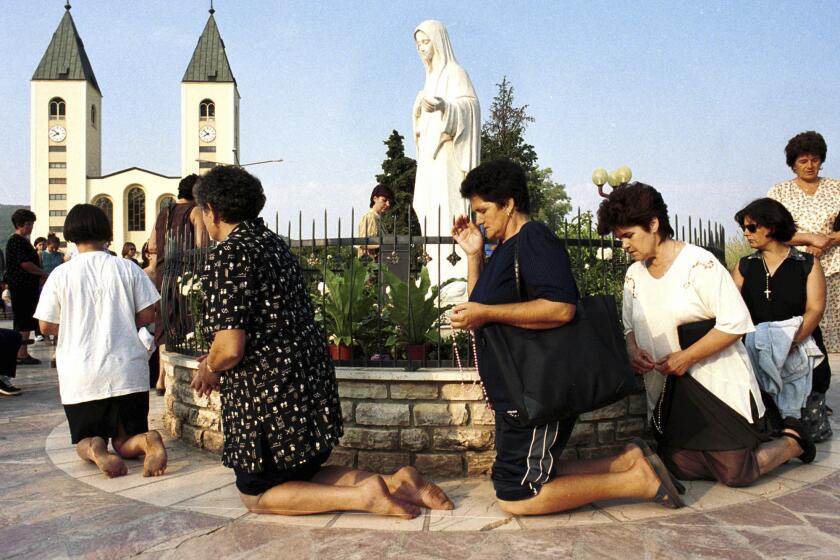Details Scarce in Push for In-Flight Security
In the airliner of the near future, armed pilots would sit in the cockpit while flight attendants trained in martial arts provide cabin service and passengers are subject to video surveillance.
Legislation that won overwhelming Senate approval this week would take on-board security to a new level, in which pilots with semiautomatics are but one element. Traditionally, crews have focused on flight safety and passenger comfort. Now, they would also be poised to become the counterterrorism strike team of last resort.
“In a nation that is as open as ours, I think it’s common sense to have a defense plan for the aircraft itself,” said Capt. Duane Woerth, president of the Air Line Pilots Assn. “It’s just being pragmatic.”
Some experts believe the government should do even more by amending the standard preflight safety briefing to exhort passengers that they too must help defend the cockpit should it ever come under attack.
But others caution that the new emphasis on airborne preparedness risks unintended consequences: lost weapons, accidental shootings, damaged aircraft and the potential for misunderstandings to escalate to greater levels of danger.
“We should approach this slowly, and test things as we do it,” said Cathal Flynn, a former security chief for the Federal Aviation Administration. “One significant problem with it is having the surety that you are identifying pilots at the [airport] checkpoint. You have to have high confidence that some armed guy with a uniform and an ID of some kind isn’t going to sail through.”
Dozens of such details were swept aside as the Senate and House debated arming pilots against the backdrop of a ground-based airport security system that still has obvious holes. There was also a recognition that armed federal air marshals can cover only a small portion of the 35,000 flights a day. But lawmakers overruled the advice of security experts at the Transportation Department against introducing firearms into the cockpit.
Now that some program appears likely to go forward, its success will hinge on finding answers to many practical questions about how it would work. The Bush administration would prefer a small test program with a limited number of pilots, but Congress wants all qualified volunteers to bear arms.
“The administration believes that there are a number of security concerns that need to be addressed as the Congress proceeds,” said White House Press Secretary Ari Fleischer. “These issues involve the proper way to train pilots who may not be proficient ... in the use of weapons.”
Airlines are concerned that bullets could damage controls or pierce the fuselage at cruising altitude, possibly bringing about a dangerous decompression.
Worries about damage to the fuselage probably could be addressed by issuing pilots a special kind of ammunition used by air marshals, which tears through human tissue but not aluminum. But the airlines have other concerns.
“You know there are going to be some misfires, you know there are going to be some cockpits shot out, you know there are going to be some people inadvertently wounded,” said an industry official, who asked not to be identified.
In large police departments, accidental weapon discharges average one a year per thousand firearms, according to statistics presented to Congress by United Airlines. It is estimated that perhaps 25,000 of the nation’s 85,000 commercial pilots would volunteer to carry weapons.
Pilots would be allowed to shoot only if an intruder has breached the locked cockpit enclosure. With bullet-resistant, reinforced doors required to be installed by April, the chances of that happening will be greatly reduced. Flynn, the former FAA official, said the government should commission a mathematical risk/benefit analysis to determine whether the odds of an accidental shooting outweigh the possibility of stopping a terrorist.
“All those risks are probably real, but I always go against the bigger risk of someone trying to hijack a plane,” said Woerth, the pilots union official. “Right now, if someone gets through the cockpit door, we’re dead. If we can figure out how to fly a Boeing 747 to Beijing in all kinds of weather, I think we can also figure this out.”
Flight attendants originally opposed arming pilots, but they were won over to the Senate bill because it also calls for greatly expanding self-defense training for cabin crews.
The legislation would create an Aviation Crewmember Self-Defense Division within the Transportation Security Administration and require consideration of arming flight attendants with stun guns.
Flight attendants would receive a minimum of 28 hours’ training, including 16 hours of “hands-on” instruction. The training would incorporate psychological, verbal and physical techniques for dealing with confrontation and teach flight attendants how to turn food service carts and other accessories into improvised weapons.
“A gun in the cockpit as the only defensive capability does nothing for the people in the cabin,” said Dawn Deeks, a spokeswoman for the Assn. of Flight Attendants. “This training will basically allow people to stay alive and buy time until the aircraft can be landed.”
Airlines would also be required to provide flight attendants with special wireless communication devices so that they could alert pilots in an emergency. And the legislation calls for video monitors that would allow pilots to see what is going on in the cabin.
However, it remains unclear when this new level of security aloft would become available. The Bush administration has estimated the cost at more than $1 billion. And allocating the money is one of the details that Congress has yet to address.
More to Read
Start your day right
Sign up for Essential California for news, features and recommendations from the L.A. Times and beyond in your inbox six days a week.
You may occasionally receive promotional content from the Los Angeles Times.






